1964 Buick LeSabre Estate Wagon: Hello, Yellow!

The various and sundry Buick Estate Wagons that existed between the 1950s and ’90s have always held a special place in my heart. Why, you ask? Well, it’s because they combine two of my favorite things: They’re part of the Broughamtastic cars produced by Detroit way back when. And they’re station wagons.

I love station wagons. I grew up with station wagons. I came home from the hospital in a station wagon. So, when I see any station wagon, I’m struck by nostalgia. True, Mom replaced her last Volvo 740GL wagon with a brand-new Dodge Grand Caravan ES in 1992, but by then I was in junior high. The wagons resonate more in my memory than the minivans.

So you combine Broughamage and “longroofs,” and you have exceedingly compelling Klockau material. And if you’re of a certain age, you will clearly remember Buick Estate Wagons, Custom Cruisers, Country Squires, and Colony Parks. Many of which were adorned with either genuine or Di-Noc wood side panels. But today’s example is wood-grain free!
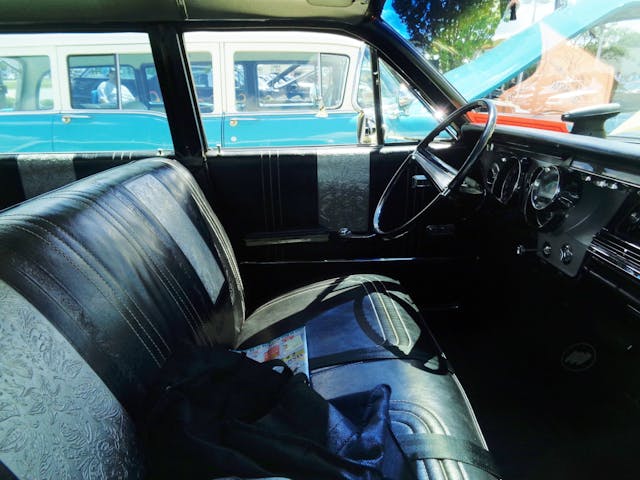
It’s hard to believe, but this 1964 example was the last year you could get any type of full-size Buick wagon until 1970. Really.

You see1, starting in 965, the big Buick wagon went away (albeit temporarily), and in addition to the ever-present midsize Skylark wagon, there was now a Buick Sport Wagon. Which, while undoubtedly Skylark/Special-based, had a slightly stretched wheelbase and shared the roof-mounted windows of its corporate sibling, the Oldsmobile Vista Cruiser. Yes, you could cruise the vistas in a Buick too.

In this fashion, the Buick Sport Wagon became the “big” Buick wagon through 1969. If you wanted a premium GM fullsize wagon from 1965–69, you had to decide between a Caprice Estate and a Pontiac Bonneville or Executive Safari.

Because Olds lost its biggie wagon from 1965–69, as well. In fact, Olds didn’t offer a new fullsize wagon until 1971. But it was worth the wait.

Then in 1970, the fullsize Buick Wagon, in Estate Wagon trim (naturally), finally came back. And it remained in the lineup all the way through the Roadmaster Estate Wagon in 1996.
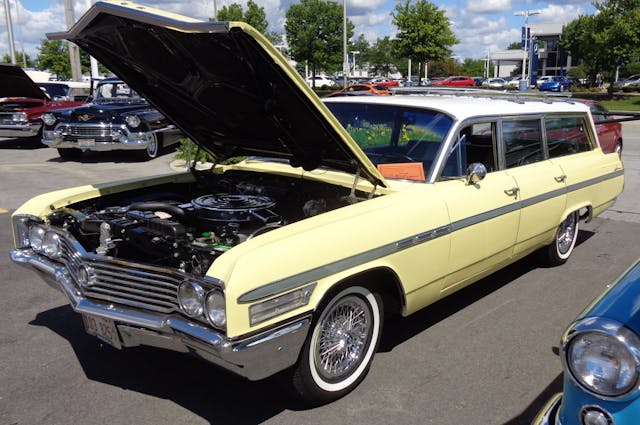
Which brings us to today’s featured station wagon, which your author went totally crazy for when he saw it. It was just gorgeous and loaded with options, including cornering lamps, roof rack, wire wheel covers, and all sorts of other goodies.
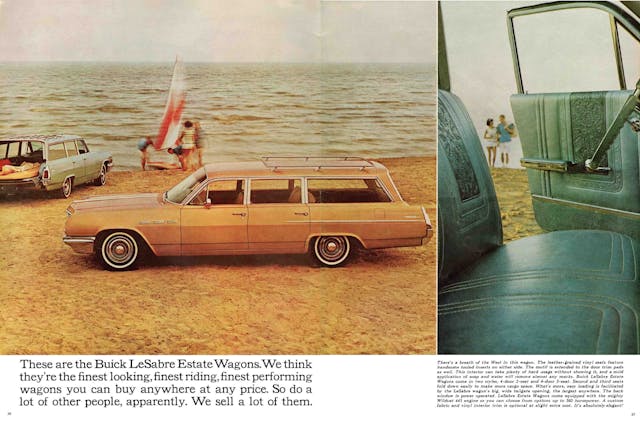
I never got a chance to speak with the owner, but I heard later from local friends that he added pretty much every factory option available when he restored it. Which made this car just dazzling! I’d never before seen a wagon of this vintage with cornering lamps; they were much more common on the flossier Electras and Rivieras.

And while it might be hard to tell in 2022, Buick was seventh in industry sales way back in 1964. Calendar-year production was, believe it or not 482,685 cars. That’s impressive considering average production of marques these days. But it was a different time, in so many ways.

Estate wagons were available in either two-seat or three-seat versions. The two-seat wagon started at $3554 ($34,166 today). It weighed in at 4352 pounds and 6517 were built.
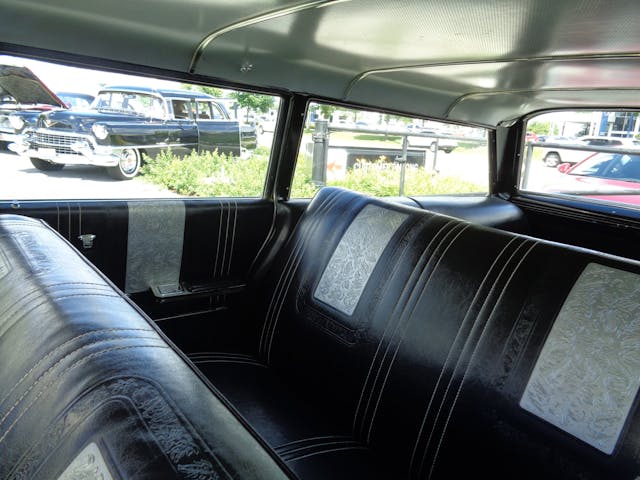
But for those who needed to haul more even more people, the three-seat wagon was available for $3635 ($34,944). A total of 4003 of those wagons were built for 1964 and were slightly heftier than the two-seat version at 4362 pounds.

Standard equipment was the Buick Wildcat 445 engine, so named due to its torque rating. Combined with the Super Turbine 400 transmission, which produced 325 horsepower at 440 rpm and 445 lb-ft of torque at 2800 rpm, it could haul you to the Grand Canyon or your kids to the local park for baseball practice.

But if you had a cabin cruiser to tow or maybe an Airstream trailer, you could get the optional Wildcat 465 V-8 engine with 425 cubic inches and a four-barrel carb, producing 340 horsepower.

But wait, there’s even more. The top engine option was the Super Wildcat with dual four barrel carbs, and it produced 360 horsepower! As the man said, you’d pass everything but a gas station. But don’t worry, gas was cheap in 1964.
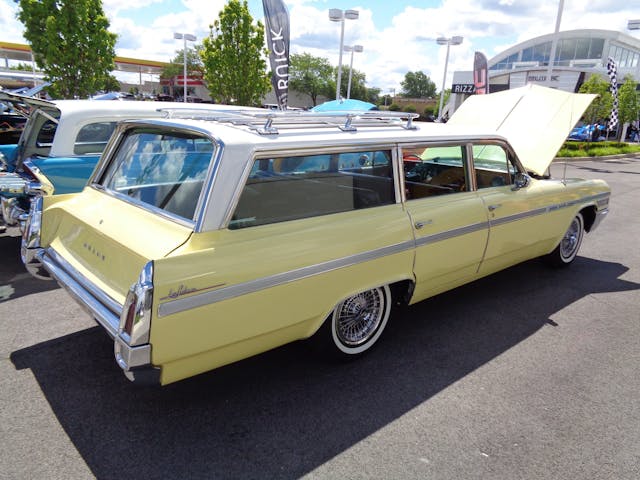
This car was at the Joe Rizza Buick Cadillac car show held in the summer of 2017. It was the first car I really locked onto, wearing that sunny color combnation (Sunburst Yellow and Arctic White, per the 1964 Buick color chart), the bling of the wire wheel covers, and corenering lamps. Awooga!

It was a great show, and I was happy to meet my friend Jonny Valadez there, since he lived in the Chicago area. He brought his ’76 Mercedes 450SL out, and it was neat to see that car too, affectionately named Bobby after one of the characters of one of his favorite shows, Dallas.

We had a great time and took many pictures, but it was sort of bittersweet because it was the last time I saw Jon before he passed away in early 2018. I’m happy to share this Buick Estate Wagon because it brings back good memories of a friend who I’ll always remember.



My little league coach had a ’58 Buick wagon with factory bright yellow paint and a red interior. Bloated Buick styling and mismatched colors not seen in any vehicle before or since. Oh yeah, hundreds of drawer pulls made up the grille. Awful.
I like wagons, though they were already well on the way to extinct by the time I was an adult.
Even factoring in back up cameras, air bags, abs, etc. you basically highlight the sales issue: the costs have gone up for newer vehicles way more than relative wages. If Buick made a full size wagon today it would be what… $80k US dollars? [keeping in mind that stations wagons 50s-60s were top of the line models in the lineups usually]
Anyways, shorten the hood. Give it a body lift and boom –you have the modern SUV (or crew cab pickup with a cap).
90s Roadmasters have a following. I owned a 64 LeSabre (great car, mine was a half-dead example). Older Buicks can be a patience test to restore compared to a Chevy.
Nailed it snailish: Shorten the hood, raise it up and you’ve got todays SUV.
During this period, many Olds and Buick station wagons had bodies built by the Ionia Body Company, in Ionia, MI., rather tha Fisher Body, like all the other GM cars. (Except the Fleetwood bodies). I’d be curious to know if this is an Ionia body car. The sill plates, which usually carry a Fisher logo, would say Ionia Body instead.
My dad had a 1964 Skylark hardtop, so naturally any 1964 Buick catches my interest – and this one is pretty cool!
A former boss had a 1970 Estate wagon, something like the one pictured above. He later traded it for a 1974-or-so Buick “clamshell” wagon, which I did not like nearly as well, although it was certainly comfortable to drive.
Here’s a walk-around of the car:
https://youtu.be/Zz5y65Ah0dg
I have one of these coral mist with the 425 4 barrel not duel though lots of options though including factory tow package
A Buick Estate wagon was a definitive suburban status symbol when new.